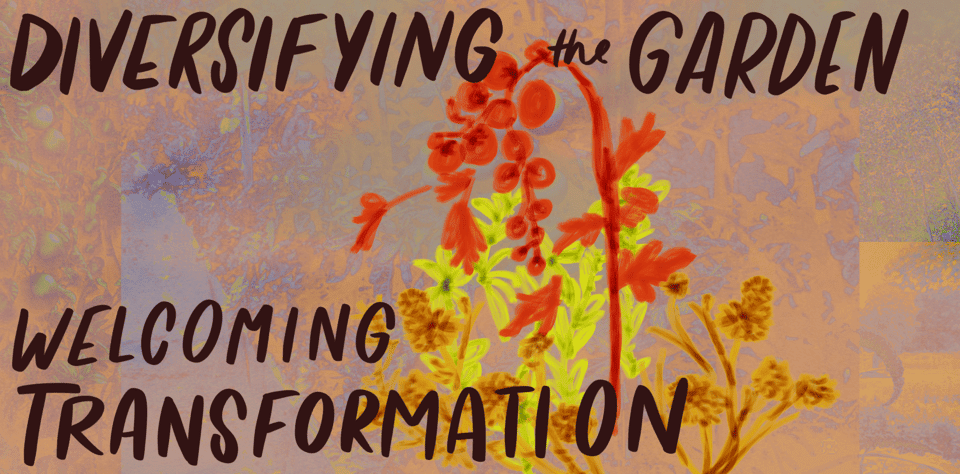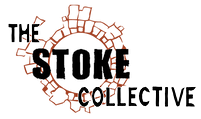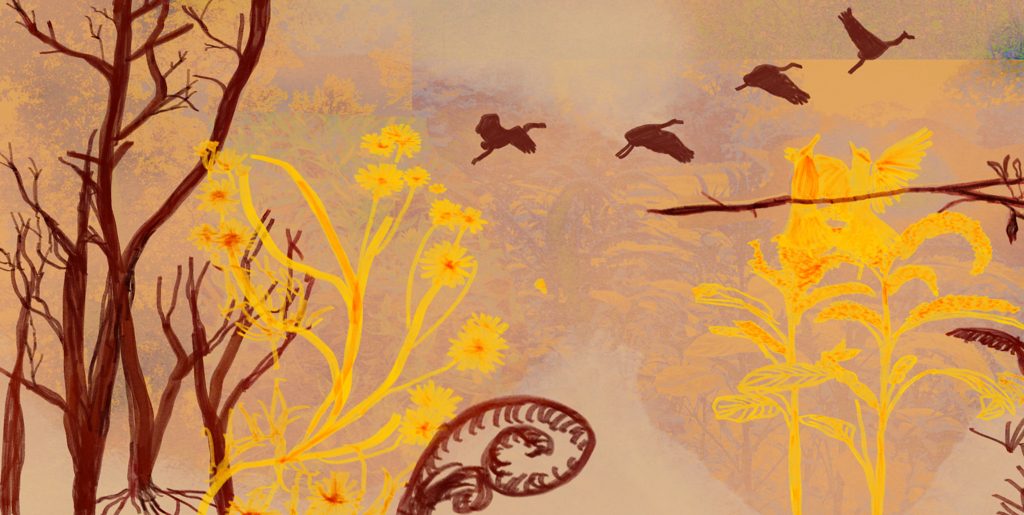This essay series was co-written and designed by Jen Sandler and Téyo Saree, with creative collaboration from other members of the STOKE Collective. We hope this series inspires reflection on difference as ecology, and how it shapes our relationships within movements and organizations working towards social change.
Ecosystems are built through relationships across differences. All kinds of differences, mutually intertwined to create a powerfully resilient and adaptive lifeworld. Ecosystems are complex multiplicities. They are not singular relationships between distinct, obviously interdependent species; a world comprised solely of bees and flowers would not long exist. There are companion plants, birds and mammals that scatter seeds, waterways filtered by yet other plantlife, microbial soil-worlds, and vast fungal underworlds that serve in ways we humans are still trying to get our heads around. Our young human species can be a healthy interdependent component of ecosystems, although in settler-colonial worlds, most of us have forgotten how to inhabit such roles.
Difference characterizes our human-centered worlds as well; just because most have pushed “nature” to the side doesn’t mean that we have eradicated difference in the human-centered worlds we have constructed. We are life, nature-beings, and difference runs through each of us. From our hopefully-diverse gut microbiomes to our many ancestors’ traumas and resiliences, we are each a magnificent and confounding manifestation of difference; learning to live with our own inner multitudes is a lifelong journey for many of us.
Difference, with all its beauty and power, also oozes into our inter-human projects. So what then, when we bring a multitude of multitudes into a room, a meeting, an organization?? A community organizing meeting may look calm, like a stand of trees in a grassy field, but it is buzzing with beings that must figure out how to coexist.
When we try to eradicate difference from our worlds — to ignore it, deny it, crush it, reject it, change it, smooth it over, erase it — we do similar violence to our social ecosystems, our community ecosystems, our organizing/activist/political ecosystems, as monocropping and clearcutting does to wild prairies and rainforests.
It may feel simple for us on the left to nod in agreement. We love a natural metaphor; we love ecologies and mycologies. Our organizations and communities are comprised of dizzying layers of identity, desires, hopes, ancestries, traumas, shames, skills, relationships, tensions, histories, griefs, joys, and on and on. Many of us might embrace this diversity in theory. But in practice? Making functional – let alone beautiful – ecologies out of all these differences is a daunting task.
In our communities and organizations, shit is getting real every day. We are trying to solve problems, right wrongs, defend our people, change policies, and build support systems. And on the daily? Well. We are making a hard decision and writing an even harder email or group chat message to justify it. We are writing that overdue report, or gathering data for a grant proposal. We are sifting through resumes, or rewriting our own. We are holding someone accountable, or begging someone else to do so. The distance between our everyday worlds and our ecological metaphor is vast.
STOKE has worked with many organizations, collectives, movements, and projects over the past eight years, and we are digging into this ecological metaphor today because it is one of the ways of thinking that helps us remember what our real work is. Thinking ecologically helps us orient to the roles we are asked to play in our own communities, in our own organization, and in support of the organizations and movements that are on the frontlines.
We hope it might help you orient or reorient to your role.
How do different beings weave together in relationship, and what does this weaving require to grow and thrive?

Storms and precarity: stewarding ecologies under non-ideal conditions
STOKE is called in often when a lot of adverse events have happened in an organization or movement. In our ecological analogy, perhaps there was a violent storm that rushed through, an unexpected external event that caused damage the ecosystem could not easily sustain. Or perhaps there was an invasive plant, a plant that might have lived in balance somewhere else but for whatever reason was destructive to the relational ecology of this place. Or perhaps an anchor plant or animal got a disease and died, those that relied on it for support started flagging as well, and the structures and practices that supported the ecosystem – attention to soil health, care and tending, attention to the many other organisms that inhabit the space – collapsed. When a few things go awry in an already-stressed organization or movement, there can be a cascade of ill effects.
We have learned that not all entities can be in relationship at all times. There are many ecosystems – many organizations, many movements, many moments; there must be space and tolerance, as the Zapatistas say, for many worlds to fit into the world we envision. Sometimes, it is not about sustaining a particular web of relationships as they have been imagined by a particular organization, but rather making the difficult decision to compost the experiences of that particular group so that they may enrich other soils. Sometimes it is about something belonging elsewhere, in a different ecological relationship-web.
When things have gone terribly wrong, sometimes there is little to be done at that moment besides acknowledge where the ecosystem is at: the soil needs a rest, the season needs to pass, there needs to be a composting or a rebuilding from the soil up. Other times, relationships can be repaired and the ecosystem can thrive anew. STOKE’s role is often to aid in the discernment about what time it is. This discernment comes from many years of close observation, in many different organizations, movements, times, and places.
Here are a few stories of ecologies coming into greater balance in our own communities:

Diversifying the garden → welcoming transformation
A community bike shop was founded and run by environmentalists, but it wasn’t necessarily welcoming to a diverse group of people. It was a single-issue type of organization, run by mostly white volunteers, and it was not capable of growing and thriving in a largely BIPOC neighborhood where it was located; youth did not see it as a space for them.
We all know organizations like this. But this one changed! The transformation began with a simple refusal to remain a weak little stand of tomato plants in a sterile raised-bed.
The bike shop had become stagnant; there was no vibrancy. Three of the white men who led the shop decided not to reopen it until something changed, but they could not make that change happen on their own. The organization was transformed by opening up to existing groups of youth bike enthusiasts and community members who supported them, people who brought in strong antiracist, anticlassist, and gender-inclusive lenses. Opening up enabled a reimagining of whose garden this is, who is truly welcome to plant and weed and water – and decide.

Aerating the soil → recognizing and giving attention to new layers of difference
In an environmental justice movement, a core group of people had a lot of experience and facility talking about the ways racial difference mattered in their work together. Race, including whiteness and indigeneity, were the relatively fixed dynamics of identity that were able to be seen, named, and talked about. But beneath the surface, there were shifting and often invisible dynamics of class that had a profound effect on the group, particularly as they went through protracted legal challenges that affected them differently. STOKE worked with this group in a difficult period, mostly calling attention to what was beneath the soil. Many in the group had never talked with one another about social class, nor had they contended with this shifting aspect of their own positionality and power. It felt strange to them to realize that there was a whole other set of dynamics shaping their experiences, but the group was able to turn its attention to the soil, to turn it over and bravely see what was there. Concerted practices of attention enabled a sort of “aeration”, loosening the soil and enabling the class dynamics to be discussed and better understood. And they were able to breathe a bit easier in their struggle together, to be together, as much as possible, as they faced violent and uncaring institutions.

Enriching the soil, fertilizing community rhizomes
In difficult times, we try to observe how small-scale effects spin out over time. Civic meetings, legislative committees, and bureaucratic boardrooms are the places where high-impact decisions are supposedly made. But when we attend meetings like these, it often feels like we are sinking into sand. Maybe you know this feeling?
- Witnessing extremely consequential decisions being made based on the thinnest of data and information.
- Watching public debate turn around the uninformed opinions of people who live their lives far from the violence their communities face.
Maybe you’ve been part of actions to make sure firsthand stories of the people with the greatest stakes are heard in such sterile official decision-making rooms. Speaking truth to power in this way – where power meets and makes decisions – can feel good, but it can also be quite frustrating. We want to pull apart these dynamics a bit, to use an ecological metaphor to expand how we think about the impact of this strategy.
On the one hand, the voices and stories of directly-impacted people rarely have an obvious effect on any particular meeting’s outcome. Real stories almost never change everything, all at once. Much of the time, they don’t even shift an important vote! When people with direct stakes step into the room, it doesn’t feel like coexisting in a lush garden, a forest, a prairie. Stories don’t usually stop the suffering.
But from the other end, when community folks who are directly affected testify consistently to their experiences, they inevitably begin to enrich the thin, sandy dirt of liberal governance. And when this happens over time, that sandy dirt has a chance of becoming fertile, more responsive soil. This is not a call for little-by-little reform, not a celebration of crumbs; it is a call to attend to the more lasting results of testimonio, and the relationships that come from this strategy.
We have seen a milquetoast legislative committee ostensibly tasked with addressing state-sanctioned torture of incarcerated people utterly shaken by the hard-won participation of formerly incarcerated people. We have witnessed community leader testimony give life to a policy committee, a zoning committee, a school committee. Even when policy decisions continue to be driven by agents of racial violence, profit, and exploitation, these are not vain efforts. Powerful relationships – surprising relationships, across unlikely lines of power and difference, are built through this hard and often unpleasant work of soil enrichment.
We don’t always know exactly how these relationships will function, but over years and decades we have seen them create an unpredictable network that acts across time and space as a resource for communities in future struggles not yet imagined. What is fertilized is not a single plant or garden, but a set of relationships that operate more like a rhizome: an underground root-system growing horizontally with many nodes, each of which is capable of activating shoots aboveground. What is aboveground can be cut down, its origin node excised even, but another will pop up again when and where the time is right.
We have seen relationships built through grassroots participation in otherwise-stodgy committees and civic meetings result in unlikely collaborations that shoot up many years later. We know it matters to enrich the soils where we live, to fertilize the rhizomes below, even as we cannot know exactly how that mattering will unfold.

Toxins, invasives, and poisons
There are maladaptive toxins already in the soil. Toxins abound in our worlds, within each of us, in the soil of our movements, and in the relationships we build. These toxins stem from industrialization, from settler-colonialism, from hetero-patriarchy, from capitalism gone bananas.
Conflict is a part of nature. Trauma and toxicity are a part of our particular historical landscapes, and they will inevitably show up in our conflicts. Everything that we are struggling against is also found within our ecosystems. But the answer simply cannot be about demanding the eradication of all toxicity; we are too far in for that. If there are PFAS in all of the water, you cannot simply refuse all drink. We have found that it is unhelpful to demand “purity” or perfect relationships in our organizations or communities. We must learn somehow to live with our individual and collective traumas, with the violence that has shaped the worlds we are rebuilding and the us that is doing the building. We must learn to practice new forms of compassion together.
Finally, and perhaps most resonant today for many of us, an obvious analogy: there are violent and invasive forms that are attempting to take over, at every scale – a meeting, a community, an organization, an institution, a nation-state. These violent invasives do not envision a landscape of interactive life; they seek to maximize only their own growth, at any expense. They aim toward a violent fiction: to “own” the space and to control everything in it.
There are many forms of poison tailor-made to limit or eliminate life, to bend the entire social ecosystem, to strain and ultimately break the relationships that hold worlds and movement spaces together. What do we do about invasives? What do we do about poisons and the immediate, large-scale threats of violence and oblivion facing our communities and movements today?

Tending to the micro ecology: Preventative care & culture building
We find it helpful to think about this big question on a micro-scale, in our everyday worlds. Can we identify the difference between invasion and trauma in our spaces? Can we figure out how to push invasives to the margins, or to worlds where they may better fit without destroying others? How do we neutralize – or even metabolize – poison, rather than feeding into it? How do we focus as much energy as possible on strengthening relationships and structures of care that protect us, rather than expending all our energy trying to eradicate what threatens us?
These are some of the hardest questions that ground us in our work, that keep us focused on the work that is ours to do. There are many other roles that are relevant in a burning world, and we hope you are finding yours at the scale in which you are living and working. It all matters, in ways we may never know.
If working across difference and building projects and organizations that can help sustain our communities through many crises is also your work, stay tuned! We will be sharing many of the specific practices and tools of our work in future essays.
We are not offering ecology as a unified framework for thinking about the relationships among movement organizations that have diverse approaches to social change; such a framework has been developed and mobilized by Ayni Institute and Momentum – check them out! Many other organizers and scholars have used ecological principles as a guide for building harmonious natural and social systems (e.g. permaculture), as a guide for municipal environmental and social-political activism (e.g. social ecology), and more. In this series, we are using ecology as a loose metaphor for thinking about how difference and relationships function (and become dysfunctional) in the everyday landscapes of our communities and organizations.
We are particularly inspired by many indigenous, Black, and queer writers and scholars who have documented different forms of relations among beings and made meaning of these relations too. Their focus on relationship, and openness to the unexpected possibilities for humans to engage in balanced relations within toxin-saturated contemporary landscapes, resonates with our experiences of diverse social change projects and movements’ relations within their communities over time. These are just a few of the people whose writing has inspired the ideas and ways of thinking that run through this essay: Vanessa Machado de Oliviera, Robin Wall Kimmerer, Kelley Hayes, Rachel Carson, Maria Popova, Gilles Deleuze and Felix Guattari, Alexis Pauline Gumbs, adrienne maree brown.


Leave a Reply